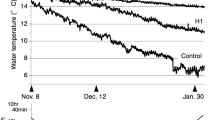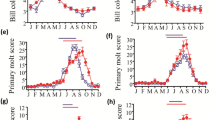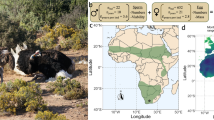Abstract
The significance of seasonal fluctuations in the components of the reproductive cycle is complex. In mammals, high environmental temperature may cause delayed puberty, delayed onset of sexual season, irregularity in cycle length, duration of estrus, ovulation rate, frequency of anovulatory estrus,morphological abnormalities in ova, fetal size and semen characteristics. High temperatures, in birds, may affect rate of egg laying, egg weight, shell quality, fertility, size of blastoderm and hatchability. Animals have developed effective thermoregulatory mechanisms for the testis. The effects of extremes of temperatures on reproduction vary with the species,breed, age, stage of reproductive cycle,period of temperature exposure, nature of temperature fluctuation and altitude. Effects of low temperature on reproduction have been little studied.
Zusammenfassung
Die Bedeutung von jahreszeitlichen Schwankungen der Komponenten im Fortpflanzungszyklus ist komplex. Bei SÄugetieren kann hohe Temperatur eine verspÄtere PubertÄt bewirken, spÄten Beginn der Brunst, UnregelmÄssigkeiten in der ZykluslÄnge,Oestrusdauer, Ovulationsrate und HÄufigkeit von anovulatorischen Oestrus, morphologische AbnormalitÄten der Eier, der Fötengrösse und des Samens.Bei Vögeln können hohe Temperaturen die LegetÄtigkeit, Eigewicht, SchalenqualitÄt, Fruchtbarkeit, Grösse des Blastoderms und Ausbrütbarkeit beeinflussen. Tiere haben wirksame thermoregulatorische Mechanismen für die Hoden entwickelt.Die Einflüsse von Temperaturextremen auf die Fortpflanzung variiert mit der Tierart, Zucht, Alter,Stadium im Fortpflanzungszyklus, Temperatureinwirkungszeit, Art der Temperaturschwankungen und Höhe. Die Bedeutung niedriger Temperatur für die Fortpflanzung ist noch wenig untersucht.
Resume
L'importance des fluctuations saisonnières sur le cycle de reproduction est complexe. Chez les mammifères, une température élevée peut causer un retard de la puberté et du rut des irrégularités de la durée du cycle et de l'oestrus ainsi que de la fréquence des ovulations; les cycles anovulatoires, les anomalies morphologiques de l'oeuf, de la semence et les variations de la grandeur fétale sont plus frequents. Chez les oiseaux les hautes températures peuvent influencer la ponte, le poids de l'oeuf, la qualité de la coquille, la fertilité, la grandeur de blastoderme et la tendance à couver. Les animaux ont développé des mécanismes thermorégulateurs efficaces pour les testicules. Les influences des extrÊmes de température sur la reproduction varient avec l'espèce, la race, l'âge,le stade du cycle de reproduction, la nature et la durée des différences de température et l'altitude. L'influence des basses températures sur la reproduction n'a pas encore été bien étudiée.
Similar content being viewed by others
References
ALLISTON, C.W. and ULBERG, L.C. (1961): Early pregnancy loss in sheep at ambient temperatures of 70‡ and 90‡ F as determined by embryo transfer. J.Animal Sci., 20: 608–613.
BARNETT, S.A. and COLEMAN, E.M. (1959): The effect of low environmental temperature on the reproductive cycle of female mice. J. Endocrin., 19: 232–240.
BONSMA, J.C. (1949): Breeding cattle for increased adaptability to tropical and subtropical environments. J. Agric. Sci., 39:204–221.
BURROWS, W.T. and KOSIN, I.L. (1953): The effects of ambient temperature on production and fertilizing capacity of turkey spermatozoa. Physiol.Zool., 26: 131–146.
CAMPOS, A.C., WILCOX, F.H. and SHAFFNER, C.S. (1960):The influence of fast and slow rises in ambient temperature on production traits and mortality of laying pullets. Poultry Sci., 39: 119–129.
COWLES, R.B. (1945a): Temperature induced sterility and evolution.Science,101: 221–222.
COWLES, R.B. (1945b): Heat-induced sterility and its possible bearing on evolution. Am.Nat., 79: 160–175.
COWLES, R.B. (1958): The evolutionary significance of the scrotum. Evolution, 12: 417–418.
DALE, H.E., RAGSDALE, A.D. and CHENG, C.S. (1959): Effect of constant environmental temperatures of 50‡ and 80‡ F on appearance of puberty in beef calves. J.Animal Sci., 18: 1362–1366.
DENISON, M.E. and ZARROW, M.X. (1955): Changes in the estrous cycle of rats during exposure to cold. Proc.Soc.exp.Biol. (N.Y.), 89:632–634.
DIMITORV, V. (1954): Calving spread over the year vs.seasonal calving of cows. Zivotn. vt. Delo (Sofija) 8 (3/4) 8.
DUTT, R.H. (1954): Fertility rate and embryonic death loss in ewes early in the breeding season. J. Animal Sci., 13: 464–471.
DUTT, R.H. and SIMPSON, E.C. (1954): Environmental temperature and fertility of Southdown rams early in the breeding season. J. Animal Sci., 13: 1019 (Abstr.).
DUTT, R.H. and BUSH, L.F. (1955): The effect of low environmental temperatures on initiation of the breeding season and fertility in sheep. J. Animal Sci., 14: 885–896.
DUTT, R.H. and HAMM, P.T. (1957): Effect of exposure to high environmental temperature and shearing on semen production of rams in winter. J.Animal Sci., 16: 328–334.
DUTT, R.H., SIMPSON, E.C., CHRISTIAN, J.C. and BARNHART, C.E. (1959): Identification of preputial glands as the site of production of sexual odor in the boar. J. Animal Sci., 18: 1557 (Abstr.).
DUTT, R.H. (1960): Temperature and light as factors in reproduction among farm animals. J. Dairy Sci., 43: 123–139.
FOOTE, W.C., POPE, A.L., NICHOLS, R.E. and CASIDA, L.E. (1957):The effect of variations in ambient temperature and humidity on rectal and testis temperatures of sheared and unsheared rams. J.Animal Sci., 16: 144–150.
GLOVER, T.D. (1958): Experimental induction of seminal degeneration in rabbits. Studies on Fertility, 10: 80–87.
HAFEZ, E.S.E. (1952): Studies on the breeding season and reproduction of the ewe. I. The breeding season in different environments. II. The breeding season in one locality. J. Agric. Sci., 42: 189–265.
HAFEZ, E.S.E., BALRELDIN, A.L. and DARWISH, Y.H. (1955): Seasonal variations in the semen characteristics of sheep in subtropics. J. Agric. Sci., 45: 283–292.
HEITMAN, H., HUGHES, E.H. and KELLEY, C.F. (1951): Effects of elevated ambient temperature on pregnant sows. J.Animal Sci., 10: 907–915.
HERIN, F.A., BOOTH, N.H. and JOHNSON, R.M. (1960): Thermoregulatory effects of abdominal air sacs on spermatogenesis in domestic fowl. Am. J. Physiol., 198: 1343–1345.
HSU, C. (1948): Influence of temperature on development of rat embryos. Anat. Record, 100: 79–90.
HULET, C.V., EL-SHEIKH, A.S., POPE, A.L. and CASIDA, L.E. (1956): The effects of shearing and level of feeding in fertility of rams. J. Animal Sci., 15: 617–623.
HURWITZ, S. and GRIMINGER, P. (1962): Egg production and shell quality in temperature and light controlled versus uncontrolled environment. Poultry Sci., 41: 499–508.
HUSTON, T.M. and CARMON, J.L. (1958): Influence of high environmental temperature on fertility and hatchability of eggs of domestic fowl. Physiol. Zool., 13: 232–235.
KOPYLOV, V.I. (1957): The effect of light and temperature on the production of geese. Vestn. sel. hoz. Nauk. Vashnil (Mosk.),2:115–119.
KOSIN, I.L. (1962): The reproduction of poultry. Reproduction in Farm Animals. E.S.E. Hafez (ed.). Lea and Febiger, Philadelphia, 277–293.
KOSIN, I.L. and MITCHELL, M.S. (1955b): Ambient temperature as a factor in turkey reproduction. 1. The effect of preheating males and females on their subsequent breeding pen performance. Poultry Sci., 34: 484–496.
KOSIN, I.L. and MITCHELL, M.S. (1955a): Ambient temperature as a factor in turkey reproduction. 2. The effect of artificially lowered air temperature on the breeding activity of males in late spring and summer. Poultry Sci., 34: 499–505.
LAW, G.R.J. and KOSIN, I.L. (1958): Seasonal reproductive ability of male domestic turkeys as observed under two ambient temperatures.Poultry Sci., 37: 1034–1047.
MacFARLANE, W.V., PENNYCUIK, P.R.,YEATES, N.T.M. and THRIFT, E. (1959): Reproduction in hot environments. In: Endocrinology of Reproduction, C.W.Lloyd (ed.). Academic Press, New York, 81–96.
McDONALD, M.W. (1960): Effects of temperature of storage and age of fowl eggs on hatchability and sex ratio, growth, and viability of the chickens. Aust. J.Agric.Res., 11: 664–672.
MIES FILHO, A. and RAMOS, A.A. (1956): Semen production of rams in Brazil.Proc.Third Internat.Congr.Anim.Reprod. (Cambridge), Sec. 3,101–103.
MOULE, G.R. (1950): Some problems of sheep breeding in semi-arid tropical Queensland. Aust. Vet. J., 26: 29–37.
MOULE, G.R. (1956): Some problems of sheep husbandry in tropical Australia. Aust. Vet. J., 32: 289–298.
NICOLESCU, I., BERINDEL, S. and STEFANESCU, M. (1960): Birth weight of Arab foals in relation to internal and external factors.Lucr.sti.Inst. Cerc.zooteh, 18: 477–493.
PETROVIC, V. (1952): The gestation period of Simmentals. God. poljopr. Fak. Zemun., 4: 363–374.
POPE, C.W., WATTS, A.B., WILLIAMS, E. and BRUNSON, C.C. (1960): The effect of the length of time in production and stage of egg formation on certain egg quality measurements and blood constituents of laying hens. Poultry Sci., 39: 1427–1431.
RAJAKOSKI, E. (1958): Seasonal variations in ovarian function in cows.8th Nord. Vet.Congr., Helsinki, pp. 549.
RAGSDALE, A.C., BRODY, S., THOMPSON, H.J. and WORSTELL, D.M. (1948): Environmental physiology with special reference to domestic animals. II. Influence of temperature 50‡ to 105‡F on milk production and feed consumption in dairy cattle. Res. Bull. Mo. Agr. Exp. Sta. No. 425, pp. 27.
RILEY, G.M. (1937): Light regulation of sexual activity in the male sparrow (PASSER DOMESTICUS). Proc. Soc. exp. Biol. (N.Y.), 34: 331–332.
ROMANOFF, A.L. (1960): The Avian Embryo. The Macmillan Co., New York, pp. 1305.
ROMANOFF, A.L., SMITH, L.L. and SULLIVAN, R.A. (1938): Cornell University Agric. Exp. Sta. Memoirs, 216: 1–42.
RUIBAL, R. 1957: The evolution of the scrotum. Evolution, 11: 376–378.
SALT, W.R. 1954: The structure of the cloacal protuberance.Auk, 71:64–73.
SHAH, M.K. 1956: Reciprocal egg transplanation to study the embryo-uterine relationship in heat induced failure of pregnancy in rabbits. Nature (Lond.), 177: 1134–1135.
SOKOLOVA, A.N. (1960): Selection of fowls on the basis of adaptation to low environmental temperature. Krasnodai: Sov.Kubanj., pp. 258–261.
SOLIMAN, F.A. and REINEKE, E.P. (1952): Influence of variations in environmental temperature and thyroid status on sexual function in young female mice.Am.J.Physiol., 168: 400–405.
TERRILL, C.E. (1962): The reproduction of sheep.Chap.14 in:Reproduction in Farm Animals. E.S.E. Hafez (ed.), Lea and Febiger, Philadelphia, 240–254.
WARREN, D.C. and SCHNEPEL, R.L. (1940): The effect of air temperature on egg shell thickness in the fowl. Poultry Sci., 19: 67–72.
WHATLEY, J.A., Jr., PALMER, J.B., CHAMBERS, D. and STEPHENS, D.F. (1957):The effect of water sprinklers on body temperature of pregnant sows and their subsequent reproductive performance. Proc.Ass. South.Agr. Workers, 54: 109–110.
WHITEMAN, J.V., and BROWN, K.J. (1959): The effect of delayed shearing of ewes and daytime cooling of rams on late spring breeding performance. J. Animal Sci., 18: 392–398.
WILLIAMS, D.D. (1958): A histological study of the effects of subnormal temperature on the testis of the fowl. Anat.Rec, 130: 225–241.
WILSON, W.O., McNALLY, E.N. and OTA, H. (1957): Temperature and calorimeter study on hens in individual cages. Poultry Sci., 36: 1254–1261.
WOLFSON, A. (1954): Sperm storage at lower-than-body temperature outside the body cavity in some passerine birds. Science, 120:68–71.
YEATES, N.T.M. (1953): The effect of high air temperature on reproduction in the ewe. J.Agric.Sci., 43: 199–203.
YEATES, N.T.M. (1956): The effect of high air temperature on pregnancy and birth weight in Merino sheep. Aust.J.Agric.Res., 7: 435–439.
YEATES, N.T.M. (1958): Fetal dwarfism in sheep-an effect of high atmospheric temperature during gestation. J.Agric.Sci., 51: 84–89.
YEATES, N.T.M. and PARER, J.T. (1962): Effects of stress on reproduction. Chap. 18. In: Reproduction in Farm Animals. E.S.E.Hafez (ed.), Lea and Febiger, Philadelphia, 297–304.
Author information
Authors and Affiliations
Rights and permissions
About this article
Cite this article
Hafez, E.S.E. Effects of high temperature on reproduction. Int J Biometeorol 7, 223–230 (1964). https://doi.org/10.1007/BF02187454
Received:
Issue Date:
DOI: https://doi.org/10.1007/BF02187454




